How to cite this page Comment citer cette page
Items
In item set
Monuments
-
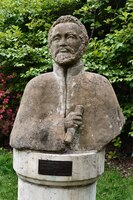 Bust of Haile Selassie The bust of Selassie, first erected in 1957, was destroyed by a group of protestors on June 30th 2020. The likely motivation for the action was a response to the killing of the Ethiopian protest singer Hachalu Hundessa in Addis Ababa the previous day.
Bust of Haile Selassie The bust of Selassie, first erected in 1957, was destroyed by a group of protestors on June 30th 2020. The likely motivation for the action was a response to the killing of the Ethiopian protest singer Hachalu Hundessa in Addis Ababa the previous day. -
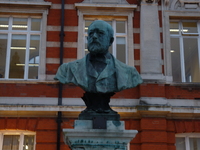 Bust of Henry Tate, Brixton
Bust of Henry Tate, Brixton -
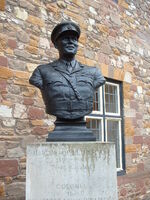 Bust of John Harding, Taunton
Bust of John Harding, Taunton -
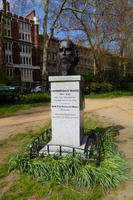 Bust of Rabindranath Tagore, London
Bust of Rabindranath Tagore, London - Bust of Victor Schoelcher, Houilles
- Bust of Charles de Gaulle, Haumont
- Bust of Charles de Gaulle, Le Morne Rouge.
-
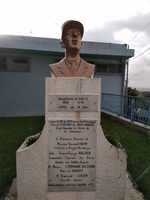 Buste de Charles de Gaulle, Vert-Pré, Le Robert Buste de Charles de Gaulle, Vert-Pré, Le Robert
Buste de Charles de Gaulle, Vert-Pré, Le Robert Buste de Charles de Gaulle, Vert-Pré, Le Robert -
Buste de Félix Eboué, La Boucan, commune de Sainte-Rose Buste en bronze placé sur un piédestal orné d'une plaque de marbre rouge sur laquelle sont gravés des extraits du discours de Félix Eboué, en décembre 1936, aux ouvriers en grève de l'Habitation La Boucan (commune de sainte-Rose)
-
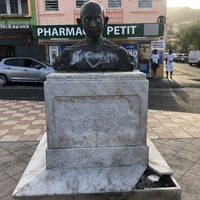 Buste de Gandhi, Fort-de-France
Buste de Gandhi, Fort-de-France -
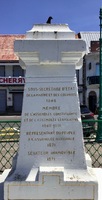 Bust of Victor Schœlcher, Basse-Terre
Bust of Victor Schœlcher, Basse-Terre -
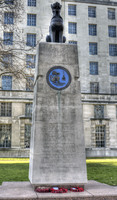 Chindit Memorial The Chindit Memorial is a war memorial in London, which commemorates both the Chindit special forces in the Second World War and Major General Orde Wingate. There is a blue plaque depicting Wingate's portrait on the reverse side of the memorial plinth.
Chindit Memorial The Chindit Memorial is a war memorial in London, which commemorates both the Chindit special forces in the Second World War and Major General Orde Wingate. There is a blue plaque depicting Wingate's portrait on the reverse side of the memorial plinth. -
 Emmeline and Christabel Pankhurst Memorial
Emmeline and Christabel Pankhurst Memorial -
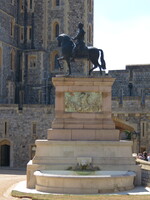 Equestrian statue of Charles II, Windsor
Equestrian statue of Charles II, Windsor -
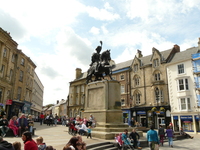 Equestrian statue of Charles Vane
Equestrian statue of Charles Vane -
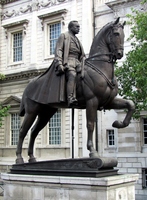 Equestrian statue of Douglas Haig, Westminster
Equestrian statue of Douglas Haig, Westminster -
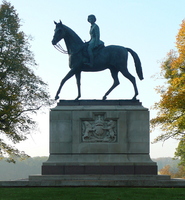 Equestrian statue of Elizabeth II, Windsor
Equestrian statue of Elizabeth II, Windsor - Equestrian statue of Frederick Prince of Wales, Hartwell House
-
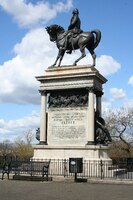 Equestrian statue of Frederick Roberts, Glasgow Duplicate of a statue erected in Kolkata, sculpted by Harry Bates. The original statue in India was inaugurated in 1898.
Equestrian statue of Frederick Roberts, Glasgow Duplicate of a statue erected in Kolkata, sculpted by Harry Bates. The original statue in India was inaugurated in 1898. -
 Equestrian statue of Frederick Roberts, Westminster Duplicate of the statue erected in Glasgow, sculpted by Harry Bates. The original statue was inaugurated in Kolkata in 1898.
Equestrian statue of Frederick Roberts, Westminster Duplicate of the statue erected in Glasgow, sculpted by Harry Bates. The original statue was inaugurated in Kolkata in 1898. -
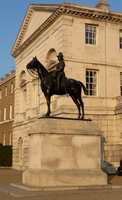 Equestrian statue of Garnet Wolseley
Equestrian statue of Garnet Wolseley - Equestrian statue of George I, Hackwood Park
-
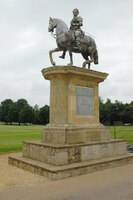 Equestrian statue of George I, Stowe The statue of George I was commissioned by Richard Temple, 1st Viscount Cobham (1675–1749), who is possibly linked to a bill of sale for 272 enslaved people and ivory purchased in Guinea and sold in Jamaica dating from 1715.
Equestrian statue of George I, Stowe The statue of George I was commissioned by Richard Temple, 1st Viscount Cobham (1675–1749), who is possibly linked to a bill of sale for 272 enslaved people and ivory purchased in Guinea and sold in Jamaica dating from 1715. -
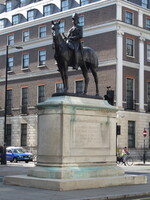 Equestrian statue of George White, Westminster
Equestrian statue of George White, Westminster -
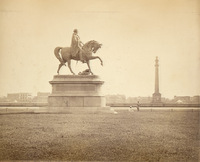 Equestrian statue of Henry Hardinge The statue of Hardinge was originally installed in Kolkata, India, in 1858, but was repatriated to the UK in 1950 after Indian independence.
Equestrian statue of Henry Hardinge The statue of Hardinge was originally installed in Kolkata, India, in 1858, but was repatriated to the UK in 1950 after Indian independence. -
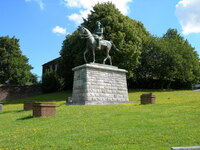 Equestrian statue of Horatio Kitchener, Medway The statue of Kitchener was originally erected in Kolkata in 1914. It was then relocated to Khartoum in 1920, before being repatriated to Chatham in 1959 after Sudan had declared its independence from Britain.
Equestrian statue of Horatio Kitchener, Medway The statue of Kitchener was originally erected in Kolkata in 1914. It was then relocated to Khartoum in 1920, before being repatriated to Chatham in 1959 after Sudan had declared its independence from Britain. -
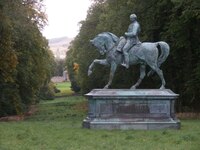 Equestrian statue of Hugh Gough The statue of Gough was originally installed in Phoenix Park in Dublin in 1878. In the mid-twentieth century, the statue became intensely contested: in 1944, it lost its head and sword, followed by its rear leg in 1956. In 1957, the Irish Republican Army (IRA) blew it off its plinth. The statue was kept in storage by the Dublin Corporation, before being sold in 1986 on the condition it left Ireland. It is now currently located at Chillingham Castle in Northumberland.
Equestrian statue of Hugh Gough The statue of Gough was originally installed in Phoenix Park in Dublin in 1878. In the mid-twentieth century, the statue became intensely contested: in 1944, it lost its head and sword, followed by its rear leg in 1956. In 1957, the Irish Republican Army (IRA) blew it off its plinth. The statue was kept in storage by the Dublin Corporation, before being sold in 1986 on the condition it left Ireland. It is now currently located at Chillingham Castle in Northumberland. -
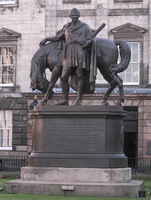 Equestrian statue of John Hope
Equestrian statue of John Hope -
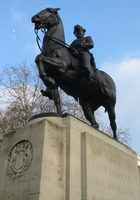 Equestrian statue of King Edward VII, Westminster
Equestrian statue of King Edward VII, Westminster -
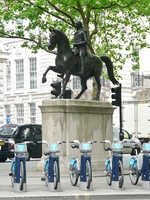 Equestrian statue of King George III, Pall Mall
Equestrian statue of King George III, Pall Mall -
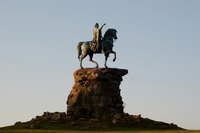 Equestrian statue of King George III, Windsor
Equestrian statue of King George III, Windsor -
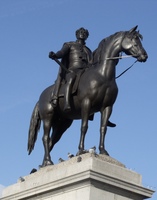 Equestrian statue of King George IV, Trafalgar Square
Equestrian statue of King George IV, Trafalgar Square -
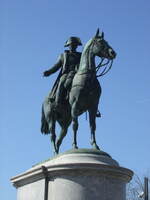 Equestrian statue of Napoléon Bonaparte, La Roche-sur-Yon The statue depicts Napoleon I on horseback, in frock coat and hat, pointing with his right hand to the site where he decided to develop the town.
Equestrian statue of Napoléon Bonaparte, La Roche-sur-Yon The statue depicts Napoleon I on horseback, in frock coat and hat, pointing with his right hand to the site where he decided to develop the town. -
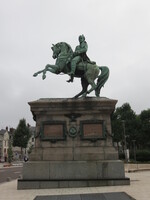 Equestrian statue of Napoléon Bonaparte, Rouen The statue depicts Napoleon Bonaparte in military dress on a prancing horse.
Equestrian statue of Napoléon Bonaparte, Rouen The statue depicts Napoleon Bonaparte in military dress on a prancing horse. -
 Equestrian statue of Prince Albert, Halifax
Equestrian statue of Prince Albert, Halifax -
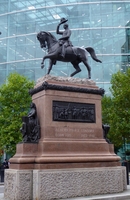 Equestrian statue of Prince Albert, Holborn Accompanied by two bronze relief panels, titled "The Prince laying the first stone of the Royal Exchange, Jan 17, 1842", and "Exhibition of All Nations, 1851, Britannia distributing awards", and two bronze allegorical girls representing "History" and "Peace".
Equestrian statue of Prince Albert, Holborn Accompanied by two bronze relief panels, titled "The Prince laying the first stone of the Royal Exchange, Jan 17, 1842", and "Exhibition of All Nations, 1851, Britannia distributing awards", and two bronze allegorical girls representing "History" and "Peace". -
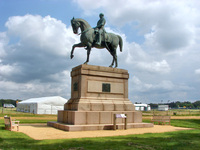 Equestrian statue of Prince Albert, Windsor
Equestrian statue of Prince Albert, Windsor -
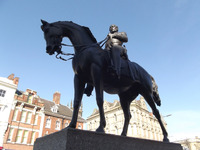 Equestrian statue of Prince Albert, Wolverhampton
Equestrian statue of Prince Albert, Wolverhampton -
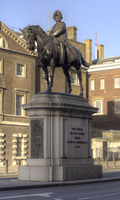 Equestrian statue of Prince George, the Duke of Cambridge
Equestrian statue of Prince George, the Duke of Cambridge -
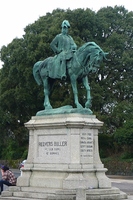 Equestrian statue of Redvers Buller, Exeter Equestrian statue of General Sir Redvers Buller and his horse "Biffen", sculpted by Adrian Jones. The statue was commissioned by the Buller Memorial Committee (established in Exeter in October 1901 after Buller's controversial dismissal from the British Army) and was unveiled in the city in 1905. The statue stands at the junction of Hele Road and New North Road, in between Exeter College and Bury Meadow Park. The statue and its plinth make direct references to Buller's colonial career. The inclusion of Buller's horse Biffen and the line on the plinth, "HE SAVED NATAL", are references to Buller's eventual victory at the relief of Ladysmith on March 1st, 1900 during the Second Boer War of 1899-1902. Other inscriptions on the plinth note the locations where Buller was involved in colonial conflicts, including India, China, Canada, Ashanti (Ghana), Sudan and South Africa. The statue of Buller is unusual in that it is a rare case of an equestrian statue depicting a military general located outside of London. Most statues of this type (which typically depicted either a monarch or a military figure) were usually installed in the metropole at the time, and the statue of Stapleton Cotton in Cheshire is probably the closest artistic counterpart to Buller's statue. Jones had considerable experience in sculpting equestrian statues beforehand, producing works such as Duncan's Horses in 1892 and Persimmon in 1895.
Equestrian statue of Redvers Buller, Exeter Equestrian statue of General Sir Redvers Buller and his horse "Biffen", sculpted by Adrian Jones. The statue was commissioned by the Buller Memorial Committee (established in Exeter in October 1901 after Buller's controversial dismissal from the British Army) and was unveiled in the city in 1905. The statue stands at the junction of Hele Road and New North Road, in between Exeter College and Bury Meadow Park. The statue and its plinth make direct references to Buller's colonial career. The inclusion of Buller's horse Biffen and the line on the plinth, "HE SAVED NATAL", are references to Buller's eventual victory at the relief of Ladysmith on March 1st, 1900 during the Second Boer War of 1899-1902. Other inscriptions on the plinth note the locations where Buller was involved in colonial conflicts, including India, China, Canada, Ashanti (Ghana), Sudan and South Africa. The statue of Buller is unusual in that it is a rare case of an equestrian statue depicting a military general located outside of London. Most statues of this type (which typically depicted either a monarch or a military figure) were usually installed in the metropole at the time, and the statue of Stapleton Cotton in Cheshire is probably the closest artistic counterpart to Buller's statue. Jones had considerable experience in sculpting equestrian statues beforehand, producing works such as Duncan's Horses in 1892 and Persimmon in 1895. -
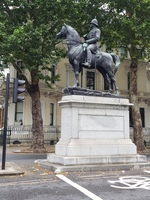 Equestrian statue of Robert Napier The statue of Napier in London is a copy of an original created by Boehm for Kolkata, India in 1883, which now stands in Barrackpore.
Equestrian statue of Robert Napier The statue of Napier in London is a copy of an original created by Boehm for Kolkata, India in 1883, which now stands in Barrackpore. -
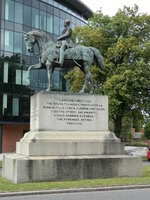 Equestrian statue of Stapleton Cotton, 1st Viscount Combermere Bronze equestrian statue of the slave-owner, colonial administrator, and military officer Stapleton Cotton, accompanied by inscriptions listing the many military campaigns and colonies Cotton was involved in.
Equestrian statue of Stapleton Cotton, 1st Viscount Combermere Bronze equestrian statue of the slave-owner, colonial administrator, and military officer Stapleton Cotton, accompanied by inscriptions listing the many military campaigns and colonies Cotton was involved in. -
 Equestrian statue of the Black Prince Although a depiction of Edward, the Black Prince, Historic England describes the equestrian statue as 'almost certainly a tribute to Edward VII'. Though the origins of "The Black Prince" as an appellation for the former Edward are uncertain, the nickname also raises interesting questions about the meanings of blackness in fourteenth century Europe, or indeed how ideas of blackness have been reconfigured in the present.
Equestrian statue of the Black Prince Although a depiction of Edward, the Black Prince, Historic England describes the equestrian statue as 'almost certainly a tribute to Edward VII'. Though the origins of "The Black Prince" as an appellation for the former Edward are uncertain, the nickname also raises interesting questions about the meanings of blackness in fourteenth century Europe, or indeed how ideas of blackness have been reconfigured in the present. -
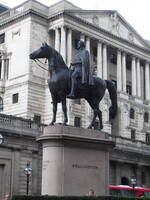 Equestrian statue of the Duke of Wellington, City of London
Equestrian statue of the Duke of Wellington, City of London -
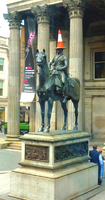 Equestrian statue of the Duke of Wellington, Glasgow
Equestrian statue of the Duke of Wellington, Glasgow -
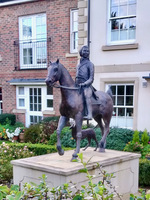 Equestrian statue of William Cobbett
Equestrian statue of William Cobbett -
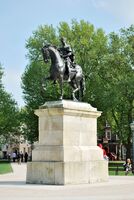 Equestrian statue of William III, Bristol The equestrian statue of William III by John Michael Rysbrack is situated at the centre of Queen's Square, which was home to many Bristol merchants and slave-traders in the eighteenth century. According to Nicola Smith, the city's merchant community and the Society of Merchant Venturers were prominent financial backers of the statue to William, with the Society contributing at least £500 to its erection. The statue was finally unveiled in 1736 amidst the peak of Bristol's involvement in the transatlantic slave trade.
Equestrian statue of William III, Bristol The equestrian statue of William III by John Michael Rysbrack is situated at the centre of Queen's Square, which was home to many Bristol merchants and slave-traders in the eighteenth century. According to Nicola Smith, the city's merchant community and the Society of Merchant Venturers were prominent financial backers of the statue to William, with the Society contributing at least £500 to its erection. The statue was finally unveiled in 1736 amidst the peak of Bristol's involvement in the transatlantic slave trade. -
 Equestrian statue of William III, Glasgow A bronze statue on granite plinth that depicts the king as Emperor Constantine. Presented by in 1735 by the Governor of Madras, James Macrae. The sculptor is unknown but a similar equestrian bronze of 1734 now in Hull was the work of Peter Scheemakers
Equestrian statue of William III, Glasgow A bronze statue on granite plinth that depicts the king as Emperor Constantine. Presented by in 1735 by the Governor of Madras, James Macrae. The sculptor is unknown but a similar equestrian bronze of 1734 now in Hull was the work of Peter Scheemakers -
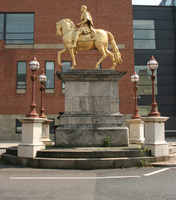 Equestrian statue of William III, Hull
Equestrian statue of William III, Hull -
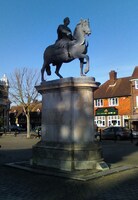 Equestrian statue of William III, Petersfield
Equestrian statue of William III, Petersfield